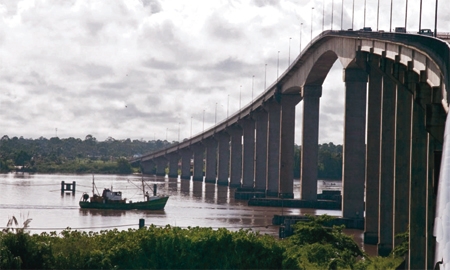Suriname’s government is well aware that to rise to its full potential, infrastructure development is a must. When the 2012 government budget was approved in February, roads, bridges, public schools and housing were all designated as key areas.
Improved transportation infrastructure could likely transform Suriname into a major hub that could link several countries within the region. The country has approximately 28,000 miles of major and minor roads, although most are unpaved. Two main arterial roads run through, called the Northern East-West Link and the Southern East-West Link. The former stretches from border to border, while the latter leaves from Apoera on the Guyana front and winds its way up to Paramaribo.
As of yet, no roads link Suriname to its southern neighbor – making these two the only South American nations not directly connected by land – but there is a master plan to connect Paramaribo to Macapa in Brazil, via Pokigron in eastern Suriname and Brazil’s Tumucumaque Park (the world’s largest protected continuous piece of pristine rain forest). The new route, which would consist of both road and railway, would link up with the existing highway that runs through Brazil’s Pedra Branca do Amapari and on to Macapa on the Amazon Delta.
A recent Business Monitor International report stated that the “most significant feature of the investment agreements are the plans to make Suriname a major transport hub linking northern Brazil (and the Amazon) to the Caribbean. The deepwater port combined with road and rail links to the Brazilian border should make Suriname a focal point of trade in the region, particularly given that neighbor Guyana has so far proved unsuccessful in its plans to develop its own deepwater port.”
The Suriname-Brazil land connection project has found financial backing in China. In 2010, Minister of Public Works Ramon Abrahams signed Memoranda of Understanding (MoUs) with two Chinese companies: Cheng Don International and China Harbor, for US$6 billion worth of investments. Other projects include the construction of a new deep-sea harbor, a sea dam from Albina to Nickerie, a new highway from Paramaribo to the Johan Adolf Pengel International Airport, and 8,000 low-income houses.
"The idea of linking Suriname to its neighbors is part of the Initiative for the Integration of the Regional Infrastructure of South America."
Ramon Abrahams,
Minister of Public Works |
Financing from other Chinese sources will go towards building bridges that will span the Corentyne and the Marowijne rivers, which form the natural borders between Suriname and Guyana and French Guiana, respectively.
Feasibility studies have already been conducted for the Corentyne River bridge and the proposed location is South Drain, Suriname to Parrot Island to mainland Guyana. The presidents of Suriname and Guyana, who hope the bridge will be completed by 2014, have observed that a road link would not only bridge states but economies and cultures, as well.
Investments in road improvements and bridge building, as well as hydroelectric dams, riverways and telecommunications links fall under a development plan dubbed the Initiative for the Integration of the Regional Infrastructure of South America (IIRSA), which seeks to connect South America’s economies.
When President Bouterse was voted into power, one of his policy priorities was to close Suriname’s housing deficit. He committed to building 18,000 houses during his term with a special view to the low and middle-income segments. Whereas previously, the Surinamese government built new subsidized homes and did all the paperwork, a new program – called the Low Income Shelter Program – is giving individual households more responsibility and autonomy and consequently lowering program costs.

2 COMMENTS
congratulations Presidente Bouterse ..
keep your promises and you will be re-elected
failing that your political career would be short lived...
build the roads and people will follow...
my dream is a UNITED STATES OF LATIN AMERICA...including carribbean and as far north as MEXICO.
KAMPTAN alias HUGO CHAVEZ...Sparticus re-incarnate.
This is great news that will have mutual benefits between Suriname and Brazil, and Suriname and Guyana,